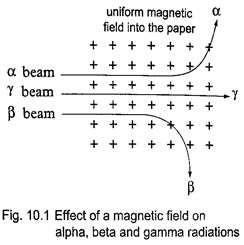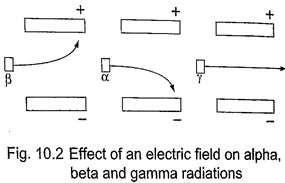a) Alpha (
α) particles
They are represented as
4, hence with a nucleus number 4 and a charge of +2.
Properties:
1. Their speeds are 1.67 × 10
7 m/s, which is 10% the speed of light.
2. They are positively charged with a magnitude of a charge double that of an electron.
3. They cause intense ionization hence loosing energy rapidly hence they have a very short range of about 8 cm in air.
4. They can be stopped by a thin sheet of paper, when stopped they capture two electrons and become helium gas atoms
5. They can be affected by photographic plates and produce flashes when incident on a fluorescent screen and produce heating effect in matter.
6. They are slightly deflected by a magnetic field indicating that they have comparatively large masses.
b) Beta (
\beta) particles
They are represented by
\operatorname*{0}_{-1}e meaning that they have no mass but a charge of -1.
Properties:
1. Their speeds are as high as 99.9% or more the speed of light
2. They are deflected by electric and magnetic fields but in a direction opposite to that of alpha particles.
3. Due to their high speed they have a higher penetrative rate than alpha particles (about 100 times more)
4. They can be stopped by a thin sheet of aluminium
5. Their ionization power is much less intense about 1/100
th that of alpha particles.
c) Gamma (
\gamma) particles
They have very short wavelengths in the order of 10
-10 m and below.
Properties:
1. They travel at the speed of light.
2. They have less ionization power than that of both alpha and beta particles
3. They accompany the emission of alpha and beta particles
4. They carry no electric charge hence they are not deflected by both electric and magnetic fields.


Mutiso answered the question on
October 17, 2018 at 07:49